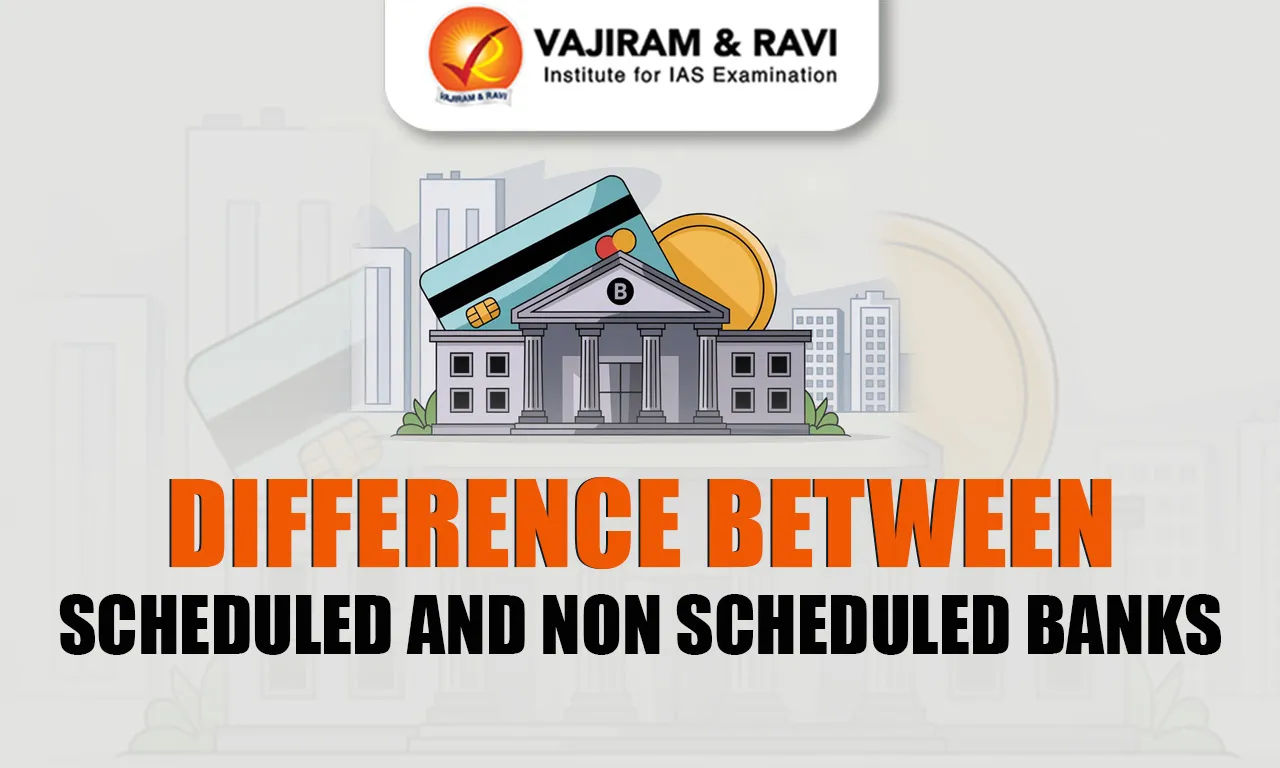The Indian banking system is broadly classified into Scheduled and Non-Scheduled Banks as per the Reserve Bank of India Act, 1934. This classification is important for understanding how different banks function under regulatory norms and their eligibility for financial facilities from the RBI.
The primary Difference Between Scheduled and Non-Scheduled Banks lies in their regulatory classification and compliance obligations. Scheduled Banks are those included in the Second Schedule of the Reserve Bank of India (RBI) Act, 1934, and they operate under specific guidelines and regulatory norms prescribed by the RBI. In contrast, Non-Scheduled Banks are not listed in this Schedule and are not obligated to adhere to the same regulatory framework, giving them a relatively limited scope of operation.
Scheduled Banks
Scheduled Banks are those financial institutions that are included in the Second Schedule of the Reserve Bank of India (RBI) Act, 1934. To qualify for this status, a bank must maintain a minimum paid-up capital of ₹5 lakhs and satisfy the RBI that its operations do not pose a threat to the interests of depositors.
A key operational requirement for Scheduled Banks is maintaining a mandatory balance with the RBI, known as the Cash Reserve Ratio (CRR). This ensures liquidity and financial stability within the banking system. In India, all major banking categories, including commercial banks, public sector banks, the State Bank of India and its associate banks, private sector banks, regional rural banks, cooperative banks, and foreign banks, can be classified under Scheduled Banks, provided they meet the requisite criteria.
To attain Scheduled Bank status, an institution must be a corporate entity (not an individual or partnership firm), maintain the minimum capital threshold, and demonstrate sound banking practices that uphold depositor confidence and financial integrity.
Key Features
- Must have a paid-up capital and reserves of at least ₹5 lakhs.
- Should not engage in activities harmful to depositors’ interests.
- Eligible for borrowing funds from the RBI at the bank rate.
- Must maintain Cash Reserve Ratio (CRR) with the RBI.
- Examples: SBI, ICICI Bank, HDFC Bank, Punjab National Bank, etc.
Non-Scheduled Banks
Non-Scheduled Banks in India are not listed in the Second Schedule of the RBI Act, 1934, as they do not meet the criteria of minimum paid-up capital (₹5 lakhs) and other conditions set by the Reserve Bank of India. These banks operate on a smaller scale, maintain their cash reserves independently, and are not eligible for RBI financial assistance or clearinghouse membership. They are considered riskier due to limited regulatory oversight and are not required to submit regular reports to the RBI. Examples include some State Cooperative Banks and Urban Cooperative Banks that serve local banking needs in specific regions.
Key Features
- Usually operate on a small scale, often region-specific.
- Not eligible for borrowing from RBI for normal banking purposes.
- Have to maintain CRR only with themselves, not with the RBI.
- Not required to follow all provisions applicable to Scheduled Banks.
- Example: Some local area banks or private financial institutions operating on a limited scale.
Difference Between Scheduled and Non-Scheduled Banks
The table below highlights the key Difference Between Scheduled and Non-Scheduled Banks in India. It compares them based on crucial factors such as RBI regulation, capital requirements, access to RBI facilities, operational scope, and reporting obligations. This comparison helps in understanding how these two categories of banks function within India’s financial system.
| Difference Between Scheduled and Non-Scheduled Banks | ||
| Basis of Difference | Scheduled Banks | Non-Scheduled Banks |
|
Inclusion |
Listed in the Second Schedule of the RBI Act, 1934 |
Not listed in the Second Schedule |
|
Minimum Capital Requirement |
At least ₹5 lakhs in paid-up capital and reserves |
No such statutory requirement |
|
Borrowing from RBI |
Eligible to borrow funds from RBI under liquidity support |
Not eligible for direct RBI support |
|
Cash Reserve Ratio (CRR) |
Must maintain CRR with RBI |
Maintain CRR with themselves |
|
Regulatory Oversight |
Subject to full RBI regulation |
Subject to limited RBI regulation |
|
Scale of Operation |
Operate on national or large scale |
Operate on a smaller, regional scale |
|
Examples |
SBI, Axis Bank, Canara Bank, HDFC Bank |
Local area banks, small private banks |
Key Points to Remember
- Scheduled Banks enjoy more credibility and access to RBI facilities.
- Non-Scheduled Banks are typically small-scale and have limited access to national-level banking privileges.
- The classification ensures a structured banking environment based on size, compliance, and stability.
- Inclusion in the Second Schedule is a mark of regulatory approval and financial soundness.
Last updated on December, 2025
→ Check out the latest UPSC Syllabus 2026 here.
→ Join Vajiram & Ravi’s Interview Guidance Programme for expert help to crack your final UPSC stage.
→ UPSC Mains Result 2025 is now out.
→ UPSC Notification 2026 is scheduled to be released on January 14, 2026.
→ UPSC Calendar 2026 is released on 15th May, 2025.
→ UPSC Prelims 2026 will be conducted on 24th May, 2026 & UPSC Mains 2026 will be conducted on 21st August 2026.
→ The UPSC Selection Process is of 3 stages-Prelims, Mains and Interview.
→ UPSC Result 2024 is released with latest UPSC Marksheet 2024. Check Now!
→ UPSC Toppers List 2024 is released now. Shakti Dubey is UPSC AIR 1 2024 Topper.
→ Also check Best IAS Coaching in Delhi
Difference Between Scheduled and Non Scheduled Banks FAQs
Q1. What is the main difference between Scheduled and Non-Scheduled Banks?+
Q2. Can Non-Scheduled Banks borrow from the RBI?+
Q3. Do Scheduled Banks have to maintain CRR with the RBI?+
Q4. Are all nationalized banks Scheduled Banks?+
Q5. Can Non-Scheduled Banks become Scheduled Banks?+

















